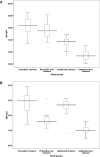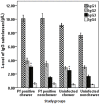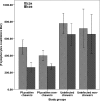Incidence of Severe Malaria Syndromes and Status of Immune Responses among Khat Chewer Malaria Patients in Ethiopia
- PMID: 26173100
- PMCID: PMC4501669
- DOI: 10.1371/journal.pone.0131212
Incidence of Severe Malaria Syndromes and Status of Immune Responses among Khat Chewer Malaria Patients in Ethiopia
Abstract
Although more emphasis has been given to the genetic and environmental factors that determine host vulnerability to malaria, other factors that might have a crucial role in burdening the disease have not been evaluated yet. Therefore, this study was designed to assess the effect of khat chewing on the incidence of severe malaria syndromes and immune responses during malaria infection in an area where the two problems co-exist. Clinical, physical, demographic, hematological, biochemical and immunological data were collected from Plasmodium falciparum mono-infected malaria patients (age ≥ 10 years) seeking medication in Halaba Kulito and Jimma Health Centers. In addition, incidences of severe malaria symptoms were assessed. The data were analyzed using SPSS (version 20) software. Prevalence of current khat chewer malaria patients was 57.38% (95%CI =53-61.56%). Malaria symptoms such as hyperpyrexia, prostration and hyperparasitemia were significantly lower (P<0.05) among khat chewer malaria patients. However, relative risk to jaundice and renal failure were significantly higher (P<0.05) in khat chewers than in non-khat chewer malaria patients. Longer duration of khat use was positively associated with incidence of anemia. IgM and IgG antibody titers were significantly higher (P<0.05) among khat chewer malaria patients than among malaria positive non-chewers. Although levels of IgG subclasses in malaria patients did not show significant differences (P>0.05), IgG3 antibody was significantly higher (P<0.001) among khat chewer malaria patients. Moreover, IgM, IgG, IgG1and IgG3 antibodies had significant negative association (P<0.001) with parasite burden and clinical manifestations of severe malaria symptoms, but not with severe anemia and hypoglycemia. Additionally, a significant increment (P<0.05) in CD4+ T-lymphocyte population was observed among khat users. Khat might be an important risk factor for incidence of some severe malaria complications. Nevertheless, it can enhance induction of humoral immune response and CD4+ T-lymphocyte population during malaria infection. This calls for further investigation on the effect of khat on parasite or antigen-specifc protective malaria immunity and analysis of cytokines released upon malaria infection among khat chewers.
Conflict of interest statement
Figures





References
-
- WHO/UNICEF. World malaria report, WHO, Geneva, 2005
-
- FMOH (Federal Ministry of Health of Ethiopia). Malaria and Other Vector-borne Diseases Control Unit. Addis Ababa, Ethiopia; 1999.
-
- Adhanom TDW, Witten HK, Getachew A, Seboxa T. Malaria In: Berhane Y, Hailemariam D, Kloos H editors. The Epidemiology and Ecology of Health and Disease in Ethiopia, 1 st edn Addis Ababa: Shama PLC; 2006. p. 556–576. http://www.malariajournal.com/sfx_links?ui=1475-2875-11-195&bibl=B1
-
- Tulu NA. Malaria In: Kloos H, Zein AZ editors. The Ecology of Health and Disease in Ethiopia. 2nd edn Boulder, USA: West view Press Inc; 1993. p. 341–352.
Publication types
MeSH terms
Substances
LinkOut - more resources
Full Text Sources
Other Literature Sources
Research Materials

